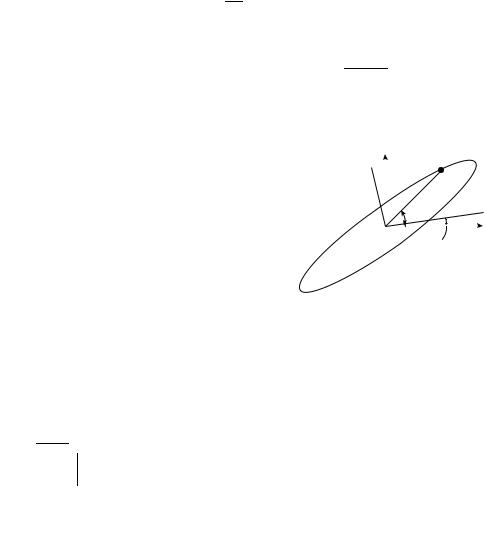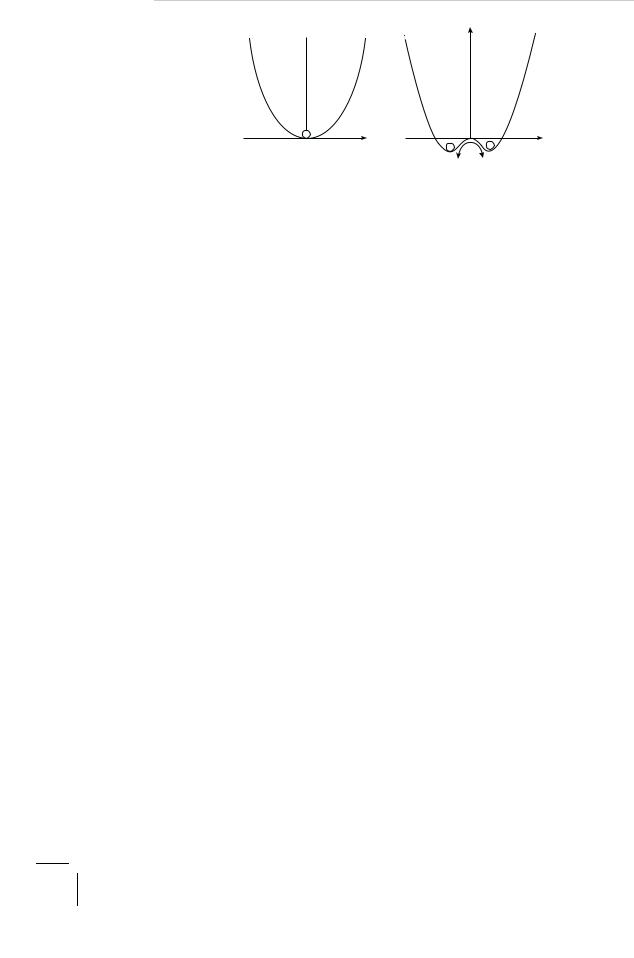
Invitation to a Contemporary Physics (2004)
.pdf
1.3. Reflection Symmetry |
25 |
θ
Figure 1.9: Rotation of plane of polarization of light by optically active medium.
be equally and identically allowed. In particular the speed of light in the two cases must be exactly the same. But what if we keep our sugar solution the same and only reverse the sense of circular polarization of light. Well, this is not symmetry related to the earlier situation, and there is no su cient reason to expect the speed of light to remain the same — it will in general be di erent. Thus the speed of light in a handed medium depends on the sense of circular polarization of the light! This e ect can be made more spectacular by taking our light to be plane polarized. Recall that it may be viewed as a superposition of two oppositely circularly polarized light waves. Now that these two components must travel with di erent speeds, they will get out of phase as they traverse the handed medium. This results in the twisting of the plane of polarization of the light relative to that of the incident light (Fig. 1.9). This twisting or rotation of the plane of polarization is called optical activity. It is perhaps the most dramatic manifestation of handedness of the medium. The substance (sugar in our case) is said to be dextrorotary (dextro = right) if the plane of polarization twists as a right handed screw. It is said to be levorotary (levo = left) if it twists as a left-handed screw. A racemic mixture of the two will leave the plane of polarization unchanged. (Somewhat confusingly, the opposite convention is also in use).
Let us re-emphasize that optical activity is due to the handedness of the substance. The law itself is even-handed, i.e., reflection symmetric. This is expressed perhaps most forcefully by the famous example of a milk drinking kitten of the Looking Glass world. Milk contains asymmetric molecules of sugar, proteins and fats. So does, of course, the body of the cat. And conventional cats love conventional milk. Reflection symmetry now demands that the reflected kitten love the reflected milk just as much, and fare just as well in all respects.
The living world is, however, far from being racemic. Thus, practically all the 20 odd amino acids that make up the proteins of the living cells are left-handed. The proteins in the living cells, in turn, have a helical backbone which is almost always right-handed. Each of the sugar phosphate chains in the double helix of the information bearing molecule DNA is a right-handed (double) helix, and a man has typically 1011 kilometers of it. Left amino acids are common and are assimilated by our body, but the right amino acids are rare and filtered out by our kidneys. The nicotine commonly found in tobacco is known to be harmful but its reflected stereoisomer is rare and much less o ensive. Limone, in perfumes, has the pleasant

26 |
Symmetry of Nature and Nature of Symmetry |
orange scent — its enantiomer smells like turpentine. The same is true of other biochemicals such as the lactic acid found in milk, or the table sugar (sucrose) found in sugarcane, etc. The sugar D-glucose is found throughout the animal kingdom but its mirror image L-sugar is unknown except in laboratory synthesis. (Handedness of drug molecules poses a serious problem — one has only to recall the tragedy of the thalidomide babies with birth defects caused by the wrong handedness of the drug molecules involved. Preparing optically pure compounds, i.e., those of a given handedness, is, however, di cult and expensive).
There are indeed few exceptions to the rule that anything from lactic acid to the double helical DNA, having handedness, will occur biologically in only one form. Indeed if we let a colony of bacteria feed on a racemic (optically inactive) mixture of (L) and right (R) sugars, the bacteria would feed preferentially on L-sugars, and then leave the mixture right-handed and optically active. The question now is, do we understand this dominance of handedness, or shall we say high-handedness of the living world when the governing laws themselves are so just and even-handed? Well, not quite. But a highly plausible answer is something like this. The observed handedness of the living matter may be the result of a fantastic amplification of an initial chance asymmetry, ever so slight. This is made possible by the positive feedback inherent in the process of multiplication (reproduction) by self-replication that is all pervasive in the animate world. To see this clearly let us simplify things to the absurd limit and consider the first (single) helical strand of the DNA molecule ever formed. We know that it is potentially equally likely to be rightor left-handed. But once formed it has got to be just one of them. So let it be right-handed. Now this single right-handed strand proliferates or multiplies by self-replication. It acts as a template and makes a copy of itself which is now necessarily right-handed. The process gets repeated over and over again. This is the positive feedback at work that may lead to the necessary amplification of an initial chance event over the aeons of chemical and biological evolution, and thus produce the handed life as we know it today. This is made all the more plausible by the observation that the inorganic world, by contrast, seems to be quite racemic. Consider the mineral quartz for example. It is one of the crystalline forms of silicon dioxide (SiO2), the common silica sand. The basic unit here is SiO2 which by itself is mirror symmetric, making quartz optically inactive when dissolved. But in a quartz crystal the units are arranged in the form of parallel helices which can be either leftor right-handed, making quartz optically active. In Nature both the forms occur with equal frequency.
Does this not go against the laws of thermodynamics, the entropy principle, that makes states of equal energy equally probable? The leftand the right-handed strands are, of course, energetically equivalent, being related by reflection symmetry. Well, the point is that the thermodynamic statement is about a system in thermal equilibrium. But the living state is far from equilibrium. It is self-organized and maintained at the cost of ‘freely’ available energy that comes eventually from the

1.3. Reflection Symmetry |
27 |
sun. Once the cell is dead, the right-handed helices of the DNA molecule will begin to flip their handedness, and gradually tend to the racemic state as dictated by thermodynamics. Indeed, the rate of racemization can be, and has been, used for the dating of dead cells older than 40,000 years or so, much better than the conventional dating based on the decay of 14C, a radioactive isotope of carbon. Louis Pasteur regarded handedness as a sign of life. Racemization signaled death.
Are the fundamental laws of physics all strictly symmetric under space reflection? Is the antipodal world of the Looking Glass just as legal as our conventional world? We now know that the answer to this question is a definite no. There are fundamental processes such as the β-decay (radioactivity) controlled by the socalled weak interaction that break this reflection symmetry. There is a screw at the very heart of Nature. To see this we have to get more sophisticated. We have seen how to reflect geometrical figures and shapes of material objects. But how do we reflect magnetism? Take a bar magnet with the poles N and S marked on its ends. Its mirror reflection will be just another bar magnet with the letters N and S laterally inverted (Fig. 1.10).
But this is a naive reflection of the body of the magnet. It hardly addresses the real question of how to reflect the magnetism of it. The magnetic field of the magnet may be regarded as due to an electric current circulating in a loop around the body of the magnet as indicated by the circular arrow (Fig. 1.10). Remember Amp`ere’s Law! (Incidentally, when Ernst Mach learnt of the sideways deflection
N
N
S
(a)M
S
(b) M
Figure 1.10: Mirror (M) reflection of (a) body of a magnet; (b) magnetism.

28 |
Symmetry of Nature and Nature of Symmetry |
of a compass needle when placed below and parallel to a current carrying wire, he was shocked out of his wits as he thought it to be violating the left-right symmetry. With our picture of the magnet, now we see that Mach’s shock was a false alarm as there is no such symmetry in this situation to start with). It should be clear now that when reflected, the sense of the circular arrow will reverse. And so will the polarity of the magnet. With this we are all set to describe the phenomenon that shook the world of physics — the fall of parity. Parity is yet another name for reflection symmetry. (Note that space reflection actually means inversion through the origin — that is letting (x, y, z) go to (−x, −y, −z). In three-dimensional space, however, the inversion through the origin and the reflection in a mirror are related through a mere rotation by 180 degrees about an axis perpendicular to the mirror plane. And, of course, the rotation symmetry is not in doubt).
Take an atom of cobalt, the isotope 60Co to be precise. The nucleus of 60Co has a spin. It is like a spinning top. This makes it a tiny magnet with the magnetic poles on the spin axis. As before, this is equivalent to having a circulating current loop indicated by the circular arrow. We now apply a magnetic field. The nuclear magnet will align parallel to this field just as a compass needle aligns parallel to earth’s magnetic field. The 60Co is a radioactive nucleus. It decays by emitting, among other things, electrons, the β-rays, in all directions. The question is whether they come out equally in all directions, or there are some preferred directions. We can know this by placing detectors all around our sample and counting the number of electrons coming out in a given direction in a given interval of time. In particular let us compare the number of electrons shot out of the north pole (N) parallel to the field with the number shot out of the south pole (S) antiparallel to the field. If we perform this experiment as Chien-Shiung Wu did in 1957, we will find that more electrons are shot out of the south pole than out of the north pole. Is this consistent with the reflection symmetry of the underlying law? To answer this all we need to do is to look at the process reflected in a mirror (Fig. 1.11).
Everything looks the same except that the sense of the circular arrow and, therefore, the polarity, is reversed. Thus in the mirror world, more electrons would come out of the north pole antiparallel to the field than out of the south pole. The reflection symmetry is violated! (This violation of parity was predicted by the two Chinese-American physicists T. D. Lee and C. N. Yang in 1956 on theoretical grounds. It was confirmed by C. S. Wu in 1957. The same year Lee and Yang won the Nobel Prize in Physics). In fact the nuclear spin of the 60Co nucleus (the circular arrow) and the preferred direction of electron emission define a left-handed screw. Nature is weakly left-handed after all! This is more than a mere convention. One could perhaps use the 60Co decay to communicate to our distant correspondent the meaning of the left and the right, and thus solve the Ozma problem. But not quite, as we will presently see.
We can go further and, as it were, pinpoint the screw by looking at the full β- decay reaction: 60Co → 60Ni + e− + ν¯e. The neutrino (or rather anti-neutrino ν¯e), as we have noted earlier, is an elusive particle with zero rest mass. This particle has

1.3. Reflection Symmetry |
29 |
e–
e–
N
Co60
60 |
Co |
|
S
e–
|
– |
(a) |
e |
M |
Velocity
νe
(b)Spin
Figure 1.11: (a) Parity violation in β-decay of cobalt-60 nucleus; (b) left-handed neutrino.
a zero charge and relativity requires it to move with the speed of light. The neutrino has spin one-half and this is important for us, since relativity demands that the spin of this massless particle be either parallel or antiparallel to its velocity! Now the spin (the circular arrow) and the velocity (the linear arrow) form a screw or a helix that can be either right-handed or left-handed. In Nature we find only left-handed neutrinos (and right-handed antineutrinos) (Fig. 1.11). Here lies the screw at the heart of Nature! All reactions involving these handed objects violate parity.
Besides parity (P), there are two other discrete symmetries — charge conjugation (C) and time reversal (T ). The symmetry operation of charge conjugation (C) replaces a particle with its antiparticle, denoted by an overhead bar. A particle and its antiparticle have the same mass but equal and opposite electric charges, among other things. Thus we speak of the anti-electron e+ (commonly called positron), antiproton (¯p), antineutron (¯n), antineutrino (¯ν), and so on. The photon (γ) is its own antiparticle. Charge conjugation symmetry demands invariance of physical laws under the operation C. Thus a reaction X + Y → Z + W and its conjugate X + Y → Z + W should proceed at the same rate. The antiworld is as allowed as our conventional world. And yet we see more electrons around than positrons, more protons than antiprotons and so on. The asymmetry seems to be of a cosmological origin, not fully understood at present. One thing should, however, be clear. We can hardly expect particles and antiparticles to co-exist in close proximity. They

30 |
Symmetry of Nature and Nature of Symmetry |
would annihilate immediately producing a flash of radiation, e.g., e− + e+ → γ + γ. This positron annihilation is used in solid state physics to study electrons in metals.
Time-reversal symmetry demands invariance of the law under the operation of time reversal (T ). Thus, if we take a movie of a process and then re-run the reel backwards, what we observe will be an equally allowed process. The reaction X + Y → Z + W is as legal as the time-reversed reaction Z + W → X + Y . The time-reversal operation (T ) requires reversing all velocities and spins in detail and interchanging past and future. Thus, at the level of elementary processes, there is no arrow of time. Microscopically, every process is reversible. (But how do we reconcile this microscopic reversibility with the all too common irreversibility of processes in complex systems — the irreversibility at the macroscopic level? What about ageing for instance? There is a thermodynamic arrow of time no doubt. The connection between the time-reversal symmetry of the microscopic laws and the observed asymmetry of complex processes has been and continues to be a subject of much debate. We will not pursue this matter here any further).
Like parity (P), the time-reversal (T ) and the charge-conjugation (C) symmetries are also approximate. There are subnuclear reactions in which C and T are individually violated. But amazingly, the combined action of these approximate symmetry operations (in any order) is an exact symmetry of nature with no violation known. Thus, if in any process we replace all particles by their respective antiparticles, reflect the resulting process in a mirror, and then reverse all velocities and interchange past and future, we will get an equally allowed process. This celebrated CPT theorem expresses a deep symmetry of Nature. “All Hell will break loose” if CPT invariance is ever found to be violated.
Finally, what about the Ozma problem? We now know why it is not su cient just to ask our otherworldly correspondent to repeat the 60Co experiment, as he (or she) may belong to the antiworld (of antimatter). There will always be an ambiguity inasmuch as both a right-handed helix of matter and a left-handed helix of antimatter will interpret the results of the experiment equally well. We must somehow ascertain before-hand whether they are made of matter or antimatter. It turns out that this is in fact possible. There are subnuclear reactions that violate time-reversal symmetry and eventually provide us with a method of ascertaining the material versus antimaterial nature of the distant world. The details are much too complicated, but the happy ending is that the Ozma problem is solved in principle.
1.4 Gauge Symmetry
We have been talking mostly about the geometric symmetries of space-time. These are the general framework symmetries without which the physical world will hardly be comprehensible. They seem so natural, almost a priori, that we take them for granted. Thus, the failure of symmetry under space reflection, even though a discrete and non-performable one, came as a great shock. Now we are approaching

1.4. Gauge Symmetry |
31 |
a symmetry of an entirely di erent kind — the gauge symmetry. It is special, it is abstract and it appeals only to a preoccupied mind. Here we are requesting invariance of the law that there be, with respect to transformations that are simply outrageous. And yet the experience of the last five decades points to these gauge symmetries as the basic dynamical principles on which the fundamental interactions (forces) of Nature are designed. The familiar electromagnetic interaction that controls much of the low-energy physics and all of chemistry, the strong interactions that hold neutrons and protons together in the nucleus, the weak interactions responsible for the radioactive decay of unstable nuclei, and possibly even the universal gravitation that holds the planets and the stars together, all seem to fit in with this general scheme as gauge fields.
A proper understanding of gauge symmetry in physics requires a background knowledge of the framework theory, quantum mechanics, which is frankly outside the scope of this discussion (see, however, Appendix B). It is possible to get acquainted with the basic idea of gauge symmetry from an example that we know from our first year in college — the example of a simple harmonic oscillator (SHO). It will be a caricature, but real enough for our purpose. Let us get down to it without further apology.
Consider a particle performing a simple harmonic motion in a plane, i.e., a two-dimensional SHO. What it means is that both its x and y coordinates oscillate sinusoidally with the same frequency. Thus the particle will in general describe an elliptical trajectory in the x, y-plane. It is convenient to combine the two motions
along the x and the y axes into the motion of a single complex variable z = x + iy,
√
where i = −1 is the imaginary unity that keeps the real and the imaginary parts of z from getting scrambled up. The position of the particle in the x, y-plane is now labeled by a single complex variable z. This is the familiar Argand diagram, or the Gauss plane, for complex numbers (Fig. 1.12).
The magnitude of z is r = x2 + y2, which is the distance of the particle from the origin O, and the polar angle θ is its angular position, where tan θ = y/x. The SHO is described by the equation d2z/dt2 + ω2z = 0. Here 2π/ω is the time
y
y |
|
z |
|
|
|
|
|
||
|
|
|
|
|
|
|
r |
|
|
|
θ |
|
|
x |
|
|
|
|
|
|
|
|
|
|
0 |
|
α |
x |
|
|
|
|
|
|
|
|
z = reiθ |
|
|
|
|
|
|
|
Figure 1.12: Elliptical trajectory of a two-dimensional harmonic oscillator in the complex plane representation.

32 Symmetry of Nature and Nature of Symmetry
period of oscillation. (We can even make ω time dependent and have parametric oscillations). As remarked before, the real and the imaginary parts of this equation do indeed describe the simple harmonic motions along the x and y axes.
Now comes the crucial observation. We have reckoned the angle θ from the x-axis. But this is just a matter of convenience. The absolute origin of the angle is irrelevant. And with this irrelevancy comes the freedom of choice. We could, for example, rotate our x, y axes anticlockwise by an angle α to new axes x , y and reckon θ from the new x -axis. This trivially amounts to replacing θ by θ − α. We say that we have re-gauged θ. All we have to do is to multiply our equation by e−iα and absorb this phase factor by redefining z = ze−iα, and our equation reads the same in terms of z . Nothing really has changed. We could do this, of course, because α was a constant, i.e., time independent. This irrelevance of absolute θ and the associated invariance of our equation is what we call the global gauge freedom and invariance. Global because it was an overall shift of θ, fixed and the same for all time. Encouraged by this, we now become more demanding. We demand freedom of choosing α di erently at di erent times. That is to say we demand invariance under time-dependent shift α(t). This is the local gauge invariance, i.e., local in time. But with α(t) varying with time, the factor eiα can no longer be absorbed by the re-definition of z because of the time-derivative occurring in our equation. It will generate additional terms involving time-derivatives of α(t). Our earlier invariance of the equation is obviously lost. The question is if we can regain it with as little and as reasonable, or natural, a modification as possible of our original equation. In other words, can we introduce something that will compensate for these additional terms? It comes as a pleasant surprise that the answer is yes. All we have to do is to replace the time-derivative d/dt occurring in our equation by d/dt − iA(t) with the proviso that re-gauging θ locally as θ −α(t) should be accompanied by a re-gauging of A(t) as A(t) − dα/dt. Here A(t) is the compensatory, or the ‘gauge’ field. That is all! But what have we gained after all this, you may well ask. Let us see. The time-dependent shift α(t) amounts to rotating our reference frame with an angular velocity dα/dt. Now we may recall from our high-school mechanics that such a rotation gives rise to ‘fictitious forces,’ namely the centrifugal force and the Coriolis force acting on our particle. The centrifugal force is the radially outward directed force you feel while riding a merry-go-round. This is the force that makes the rotating earth bulge out at the equator. The Coriolis force is the force that makes you swerve sideways when you try to walk on a rotating platform. This is the force that deflects the winds and the ocean currents to the right (left) in the Northern (Southern) hemisphere due to Earth’s rotation. After a little calculus our equation will show that the ‘gauge field’ A(t) generates precisely these forces automatically. Thus, the requirement of local gauge invariance has created the right kind of forces acting on the particle in accord with experience. Is this not wonderful? This is the essence of local gauge symmetry.
It is now believed that all the fundamental forces of nature, the electromagnetic, the weak, the strong, and even the gravitational, are generated just this way. One

1.5. Spontaneous Symmetry Breaking (SSB) |
33 |
has to simply identify the correct global symmetry (the irrelevancy) that is to be gauged locally. This is where all the ingenuity and the insight of the theorist lie. We have spoken of the irrelevance of the absolute origin of space and time, and the irrelevance of the absolute orientation in the Minkowski space-time. When these global symmetries are gauged locally, we get Einstein’s general theory of relativity that replaces the old-fashioned Newtonian gravitation acting in the old-fashioned Euclidean space. Thus gravitation appears as a gauge field. The idea of local gauge invariance really comes into its own only when it is combined with the framework of quantum mechanics, with all its built-in redundancies, irrelevancies and unobservables. For instance, as we have remarked earlier, the absolute phase of the wave function ψ of an electron is irrelevant. It can be changed globally by an arbitrary constant. But when we gauge it locally, the compensating force turns out to be just the electromagnetic force that we know so well from our experience. It couples to (acts on) the charges and the currents as it should. In point of fact, should we replace the single independent variable t in our oscillator equation by the three space co-ordinates (x, y, z), generalize the gradients appropriately, and let z(t) become ψ(x, y, z), our equation will become the Schr¨odinger equation for a charged particle moving in a magnetic field represented by the gauge field A(x, y, z), the so-called ‘vector potential.’
When this gauge principle is applied to relativity-plus-quantum mechanics, it becomes the formidable gauge-field theory of physics today. The principle of local gauge invariance has become the guiding principle in our quest of fundamental understanding in the domain of the very small as well as the very large. Let us hasten to add that the same general principle appears again and again in our world of middle dimensions — the physics of condensed matter. So, next time you hear of gauge invariance, it may well be the gauge theory of ordinary glass, or its magnetic cousin, the ‘spin glass.’
1.5Spontaneous Symmetry Breaking (SSB)
Finally, we come to discussing an idea which is as deep as the idea of symmetry itself, or perhaps even deeper. Its time came much later. But now it is seen as a physical principle that holds the key to unifying all the fundamental forces of Nature, the electromagnetic, the weak, the strong and possibly even the gravitational. This has been in one form or another, the all-time dream of physicists. It is already partially realized now, and some say that the end is in sight. But, first, what is spontaneous symmetry breaking? Let us define it. A symmetry is said to be broken spontaneously if the symmetry of the state of the system is lower than (is a subgroup of) the symmetry of the force law governing the system. Mark you, we do not break the symmetry of the law itself. We have already hinted at such a possibility
— remember the elliptical orbit of the earth around the sun in spite of the spherical

34 Symmetry of Nature and Nature of Symmetry
V(x) V(x)
V(x)
x |
x |
(a) |
(b) |
Figure 1.13: Particle in a symmetrical potential well: (a) symmetric state; (b) spontaneously- broken-symmetry state.
symmetry of the gravitational force of the sun! To fix the idea, let us consider two examples, the first a trivial one, taken from mechanics, and the second a highly non-trivial one taken from statistical mechanics where it all began.
Take a piece of wire. Bend it in a U-like shape and hold it vertically. Now slip a bead on the wire and let it slide freely on it. It is common knowledge that the bead will oscillate for a while and eventually settle down (due to friction) at the bottom of the U-wire (Fig. 1.13), this being the state of lowest potential energy (equilibrium).
The gravitational potential energy measured from the bottom is proportional to the height. Thus, the U-wire is really a ‘potential well’ with a single potential minimum at the bottom. Notice that the potential is symmetrical about the vertical through this minimum. Thus the state of the system has the same symmetry as the potential (the force law). Now, let us flatten the bottom part of our U-wire and finally make it convex upwards. We will now have two local minima of the potential located symmetrically about the midpoint which now becomes a local maximum. What should we expect now? The potential is still symmetrical about the vertical through the midpoint, but this is now a state of unstable equilibrium. A disturbance, however small, will tilt the balance in favor of one or the other of the two minima and the bead will roll down accordingly. Let it roll down to the right-side minimum. Now, the symmetry of this lopsided state is definitely lower than the symmetry of the potential which is still symmetrical about the vertical axis. This is spontaneous symmetry breaking. Broken symmetry agreed, but what is spontaneous about it, you may ask. After all we did need some disturbance to break it. Well, the point is this. The disturbance needed to break the symmetry of the state can be made arbitrarily small. Even the tiny thermal jiggling of molecules in the wire will do. The e ect produced, namely the rolling down to one of the minima, is totally out of proportion to this tiny disturbance which could in principle be made almost zero — we have here a critically poised atom! This is why it is called spontaneous. (One is reminded of Buridan’s ass. The hapless ass was placed symmetrically between two identical bales of hay. The ass was hungry but the very symmetry (equidistance) of the two options forbade him from making up his mind and, as the parable goes,
